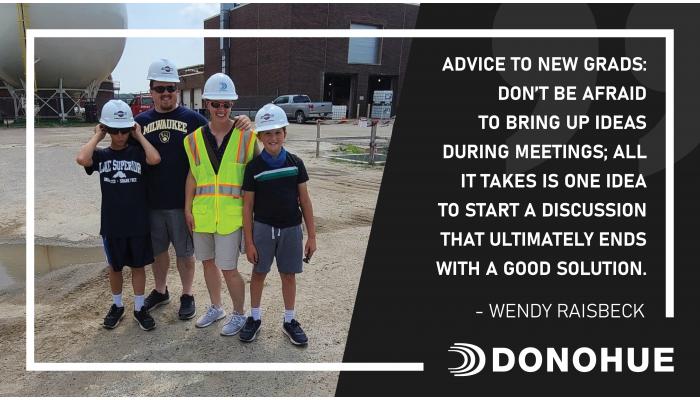
Tell me about yourself, your schooling, career path.
I graduated from UW-Platteville with a bachelor’s degree in environmental engineering and civil engineering with an environmental emphasis. During college, I worked as a co-op for Donohue and became a full-time employee after graduation; I’ve been here 18 years. When I started, I generally was helping other process-mechanical engineers with their designs on projects. As got more experience, I became more independent and started working on my own process-mechanical designs and eventually started doing project management as well. For the most part, I work on municipal wastewater treatment plant projects, but I have also worked on industrial wastewater treatment plants, municipal water treatment plants, and collection system lift stations. Internally at Donohue, I am part of the hydraulics committee (performing quality reviews of hydraulic calculations) and the cost estimating committee, and have become a senior level process-mechanical engineer and project manager.
Why did you pursue a career in engineering?
Growing up, I always liked math and science through anything water and air. Though I didn’t really know what I wanted to do after college when I started, as I went through my college courses I developed an interest in wastewater treatment. After my co-op with Donohue, this interest was secured.
What’s your favorite part of your job?
There’s always something interesting going on, like a challenging design problem to solve, a situation at startup to figure out, or finding the reason that calculations are not matching up with what is actually happening at a plant as part of a plant investigation, to name a few. I also enjoy being part of the project from start to finish; from preliminary evaluations, through design, bidding, construction, and, on occasion, testing after construction. It is very rewarding going through this process with our clients.
Tell me about the most challenging project you were involved with and what you did you fix it.
It is difficult to pick out just one challenging project, but the most challenging part of projects is sequencing construction while making sure wastewater treatment can be maintained. At times, this does require designing and constructing additional infrastructure to do so. In Wausau we designed a primary effluent channel to be able to take the leaking primary effluent pipe out of service; this also freed up space in the existing tunnel and helped plant hydraulics. In La Crosse, we designed a structure over the secondary effluent pipes and added additional piping that allowed flow around a tank that otherwise was not able to be bypassed to allow work within the tank. In many projects, thinking about constructability early in the design is required to be able to sequence construction similar to these examples.
Where were you in life 5 years ago? 10 years ago? What do you wish you knew back then?
Ten years ago, I was working with others as a process-mechanical design engineer, but I was not a lead engineer. I wish I would have known how to communicate better and understand how others on the team work. I now understand how important this is to completing a project successfully, on time, and on budget.
What advice would you give someone just starting out?
Ask as many questions as you can think of and don’t feel bad doing so. Just because you don’t know the answer right now, doesn’t mean it’s not a valid question. Additionally, during meetings, don’t be afraid to bring up your ideas even if you don’t think it’s a good one; sometimes all it takes is an idea to start a discussion that ultimately ends with a good solution.
What do you do for fun?
I have two sons that keep me busy; I enjoy watching their activities and watching them as they grow. I also enjoy gardening, going for hikes and bike rides, camping, listening to music, being involved in my church, and being part of my community’s sanitary district.
